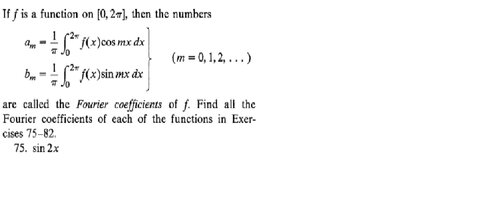Hello.
(Refer to the picture, Exercise 75.)
I don't think I really understand these formulas. I integrated and found
[math]a_m= \frac{1}{\pi} \int_{0}^{2\pi} \sin 2x cos mx \, dx= \frac{2cos({2\pi m})-2}{{\pi}(m^2-4)}[/math]Now, I don't know how to find m. I read that for any odd function [math]a_m=0[/math]So in this case, for [math]f(x)=sin(2x)[/math] [math]a_m=0[/math] I believe this is because areas cancel each other
My real struggle starts with [math]b_m[/math] From the formula given by the book I know that [math]b_m= \frac{1}{\pi} \int_{0}^{2\pi} f(x)sin(mx)dx[/math]Integrating this with [math]f(x)=sin(2x)[/math] I obtain [math]b_m= \frac{2sin(2\pi m)}{\pi (m^2-4)}[/math]Again my problem is with m. I don't know how to find m. And once I know m what do I have to do? Plug m in both formulas for [math]a_m[/math] and [math]b_m[/math] and find both integrals?
Thank you for your time, and please feel free to write back if I typed something wrong or I didn't provide enough information.
(Refer to the picture, Exercise 75.)
I don't think I really understand these formulas. I integrated and found
[math]a_m= \frac{1}{\pi} \int_{0}^{2\pi} \sin 2x cos mx \, dx= \frac{2cos({2\pi m})-2}{{\pi}(m^2-4)}[/math]Now, I don't know how to find m. I read that for any odd function [math]a_m=0[/math]So in this case, for [math]f(x)=sin(2x)[/math] [math]a_m=0[/math] I believe this is because areas cancel each other
My real struggle starts with [math]b_m[/math] From the formula given by the book I know that [math]b_m= \frac{1}{\pi} \int_{0}^{2\pi} f(x)sin(mx)dx[/math]Integrating this with [math]f(x)=sin(2x)[/math] I obtain [math]b_m= \frac{2sin(2\pi m)}{\pi (m^2-4)}[/math]Again my problem is with m. I don't know how to find m. And once I know m what do I have to do? Plug m in both formulas for [math]a_m[/math] and [math]b_m[/math] and find both integrals?
Thank you for your time, and please feel free to write back if I typed something wrong or I didn't provide enough information.

